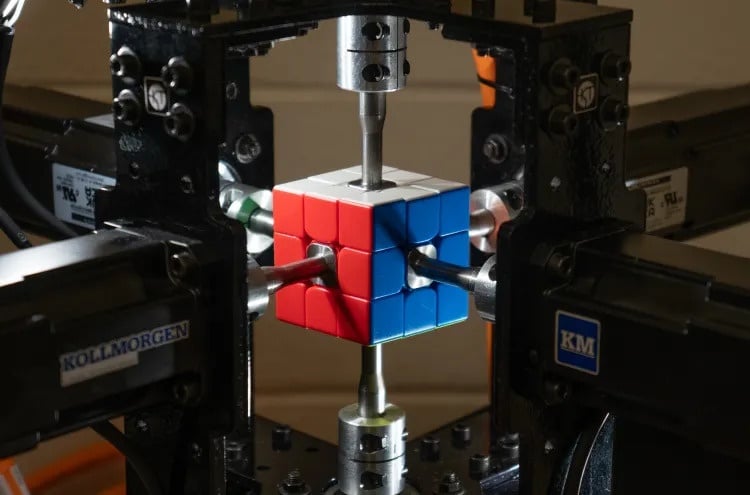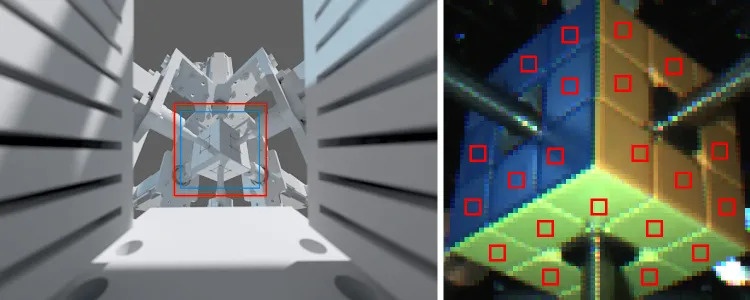 |
The Rubik's Cube solving machine created by a group of students has set a world record. Photo: Provided by the team . |
A group of Purdue University students recently set a new Guinness World Record with a robot they designed themselves, capable of solving a Rubik's Cube in just 0.103 seconds. This is three times faster than the previous record set by another robot.
Behind the record wasn't a robot that moved faster. The student team combined a high-speed but low-resolution camera system, a custom-designed Rubik's Cube for increased durability, and a special solving technique popular among speed Rubik's Cube solvers.
Key differentiators compared to competitors.
The race to build Rubik's Cube-solving robots began in 2014, when a robot assembled from a Lego Mindstorms kit and using a Samsung Galaxy S4 phone solved the Rubik's Cube in just 3.253 seconds. In May 2024, engineers at Mitsubishi Electric in Japan claimed the world record with a robot solving the Rubik's Cube in 0.305 seconds.
To bring the robot's Rubik's Cube solving time down to under half a second, the team abandoned the use of Lego components and instead used optimized parts such as industrial motors. But to achieve the 0.103-second mark, the Purdue team refined the speed at which their robot could "see" the scramble of the Rubik's Cube.
Speed Rubik's Cube solvers can observe the cube before the timer starts. However, the timer will also factor in the time it takes for the robot to identify the location of each colored square on the faces.
The group of students used two high-speed machine vision cameras from Flir, with a resolution of only 720x540 pixels, placed at opposite corners of the Rubik's Cube. Each camera could simultaneously observe three faces of the cube in a single shot lasting only 10 microseconds.
 |
The robot's extremely fast color recognition technology. Photo: Provided by the author. |
Conventional cameras still need time to process data from the sensor and convert it into a digital image. However, Purdubik's Cube, the robot created by the student group, uses a custom image recognition system that completely bypasses this image processing step.
This system focuses on a very small area (128x124 pixels) within the frame each camera records, reducing the amount of data that needs to be processed. Raw data from the sensors is sent directly to a high-speed color detection system, which uses RGB values from even smaller sample regions to determine color faster than both conventional and AI methods.
Although this method is less stable, it can ensure the group's primary requirement is met. "Even if the accuracy is only 90%, that's still good enough. What we really need is speed," shared Patrohay, a student in the group.
Optimize the entire system.
Patrohay argues that each previous record-breaking robot typically only improved one outstanding feature. The robot by the MIT student team (2018) focused on using high-performance industrial hardware. The Mitsubishi Electric team chose specialized electric motors, optimized for rotating each face of the Rubik's Cube.
Meanwhile, the Purdue team opted for readily available software to optimize the entire system, from the camera and image processing to the hardware and solving algorithms. They used Elias Frantar's Rob-Twophase, a Rubik's Cube solving algorithm specifically designed for robots, allowing them to leverage special capabilities such as rotating both sides of the Rubik's Cube simultaneously.
The group also utilized a technique that allows them to begin rotating one side of the Rubik's Cube before completing the rotation of the other side perpendicular to it. This method saves considerable time, but it risks damaging or even shattering the Rubik's Cube if the timing is wrong or too much force is used. Therefore, the students had to further customize the Rubik's Cube to withstand the force and operate smoothly with this technique.
According to the World Rubik's Cube Association (WCA) rules, participants can customize their Rubik's Cube, as long as it can still rotate and function like a standard cube, with 9 colored squares on each face, and 6 faces with 6 different colors. Players can use materials other than plastic, but the colored sections must have the same surface texture.
 |
Six motors like these will be attached to the remaining sides, tasked with rotating the Rubik's Cube. Photo: Provided by the author. |
To increase durability, the Purdue team upgraded the internal structure of the Rubik's Cube with a custom 3D-printed version using a tougher SLS nylon resin. Increased lubrication and tension simultaneously help reduce over-rotation and improve control.
Purdubik's Cube uses six motors attached to metal shafts located in the center of each face of the Rubik's Cube. After experimenting with various methods, the team chose to use a trapezoidal movement system so that the robot could precisely align each face when it stopped.
Patrohay believes Purdubik could break his own record if the Rubik's Cube were more durable and made from a material other than plastic. "If you made a specialized Rubik's Cube entirely from a carbon fiber composite, I think it would withstand higher speeds. That would allow you to further shorten the time," he said.
Source: https://znews.vn/ben-trong-robot-giai-rubik-nhanh-nhat-the-gioi-post1557575.html






![[Photo] Prime Minister Pham Minh Chinh presides over a meeting on private sector economic development.](/_next/image?url=https%3A%2F%2Fvphoto.vietnam.vn%2Fthumb%2F1200x675%2Fvietnam%2Fresource%2FIMAGE%2F2025%2F12%2F20%2F1766237501876_thiet-ke-chua-co-ten-40-png.webp&w=3840&q=75)



























































































Comment (0)